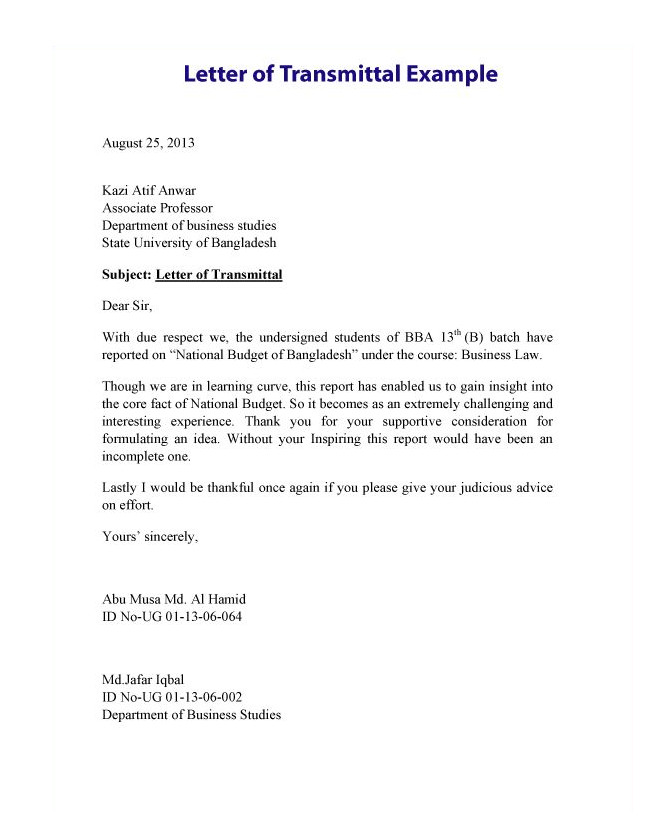Regarding business communication, ensuring that important information is delivered correctly and on time is crucial. One way to do this is by using a letter of transmittal, a formal document that accompanies a larger document to introduce it, explain its purpose, and provide instructions for use.
This article will delve into the topic of a letter of transmittal, discussing its significance, how to create one, and providing examples and tips for successful implementation.
What is a Letter of Transmittal?
A letter of transmittal is a document that serves as an introduction to a larger document, such as a report, proposal, or contract. It provides a summary of the enclosed document, explains its purpose, and provides instructions on how to use it. This letter is typically addressed to the recipient and includes important details such as the sender’s contact information, the date of transmission, and any specific requirements or deadlines related to the enclosed document.
A letter of transmittal is used to ensure that important information is delivered correctly and on time. It helps to establish a clear communication channel between the sender and recipient, ensuring that both parties are on the same page regarding the enclosed document. This formal document also adds a professional touch to the communication process, demonstrating the sender’s attention to detail and commitment to effective communication.
Why Use a Letter of Transmittal?
Using a letter of transmittal offers several benefits in business communication:
- Clarity: A letter of transmittal provides a concise summary of the enclosed document, making it easier for the recipient to understand its purpose and context.
- Instructions: By including instructions on how to use the enclosed document, a letter of transmittal ensures that the recipient knows what to do with the information provided.
- Professionalism: Including a formal letter of transmittal adds a professional touch to the communication process, showcasing the sender’s attention to detail and commitment to effective communication.
- Organization: A letter of transmittal helps to organize the communication process by clearly identifying the sender, recipient, and purpose of the enclosed document.
- Documentation: By providing a written record of the transmission, a letter of transmittal serves as proof that the document was sent and received.
How to Create a Letter of Transmittal
Creating a letter of transmittal involves several key steps:
- Header: Begin by including a header that includes your contact information, such as your name, title, company name, address, phone number, and email address.
- Date: Include the date of transmission, typically aligned with the right margin beneath the header.
- Recipient Information: Provide the recipient’s name, title, company name, address, and any other relevant contact information.
- Salutation: Begin the letter with a formal salutation, such as “Dear [Recipient’s Name],” followed by a colon.
- Introduction: In the first paragraph, introduce yourself and briefly explain the purpose of the letter and the enclosed document.
- Summary: Provide a concise summary of the enclosed document, highlighting its main points and key findings.
- Instructions: Clearly state any instructions or guidelines for using the enclosed document.
- Closing: Conclude the letter with a polite closing, such as “Sincerely,” followed by your name and title.
- Attachments: If there are any additional documents attached, list them at the bottom of the letter.
Example of a Letter of Transmittal
Here is an example of a letter of transmittal:
[Your Name]
[Your Title]
[Company Name]
[Address]
[Phone Number]
[Email Address]
[Date][Recipient’s Name]
[Recipient’s Title]
[Company Name]
[Address]Dear [Recipient’s Name],
I am pleased to submit to you the enclosed [name of the document], which serves as a comprehensive report on [subject or purpose of the document]. This document provides valuable insights and recommendations that will help [recipient’s company or organization] in [specific area or goal].
The [name of the document] consists of [number of pages] pages and includes a detailed analysis of [key findings or sections]. It is organized in a clear and logical manner, allowing for easy navigation and reference. The document also includes [any additional attachments or appendices].
To effectively utilize the information provided in the [name of the document], please review the document in its entirety. Pay particular attention to the [specific sections or recommendations] as they offer valuable insights and actionable recommendations for [how the recipient can benefit].
If you have any questions or require further clarification, please do not hesitate to contact me at [phone number] or [email address]. I am available to discuss the enclosed document and address any concerns you may have.
Thank you for your attention to this matter, and I look forward to hearing your feedback on the enclosed document.
Sincerely,
[Your Name]
[Your Title]




Tips for Successful Use of a Letter of Transmittal
Here are some tips to ensure the successful use of a letter of transmittal:
- Be concise: Keep the letter brief and to the point, focusing on the key highlights of the enclosed document.
- Use a professional tone: Maintain a formal and professional tone throughout the letter, showcasing your professionalism and attention to detail.
- Proofread: Before sending the letter, carefully proofread it for any grammatical or spelling errors.
- Include contact information: Make sure to provide your contact information, including your name, title, company name, address, phone number, and email address.
- Follow up: After sending the letter, follow up with the recipient to ensure that they have received and understood the enclosed document.
Conclusion
A letter of transmittal is an essential tool in business communication, ensuring that important information is delivered correctly and on time. By providing a concise summary of the enclosed document, explaining its purpose, and providing instructions for use, a letter of transmittal helps to establish a clear communication channel between the sender and recipient.
By following the steps outlined in this article and incorporating the tips provided, you can create an effective letter of transmittal that enhances your business communication and ensures the successful delivery of important information.
Letter of Transmittal Template – Download
